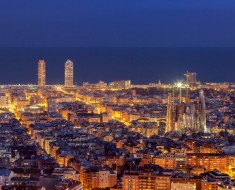This is one of the cities which is on everyone’s tourist trail, and perfect for a weekend break. We were there for a few days some years ago, and delighted in the consistent elegance of the buildings, and the spacious main squares reminiscent of Vienna, and enjoyed the relaxed atmosphere of the city. Mozart’s city some call it, for here his opera Don Giovanni was first performed, and his music is suited to the small chamber ensembles which frequently hold concerts in many of the churches as well as concert halls. There were several jazz groups playing in the streets when we were there, contributing to the feel of a city presenting itself positively to visitors such as ourselves.
Prague Castle – the seat of government and historically the home of successive Bohemian kings – is huge and, dating, from the 9th Century, is regarded as the largest ancient castle in the world. It has a commanding presence above the city and contains within itself St. Vitus Cathedral, the most important church in the Czech Republic and a superb example of gothic architecture.
The city has a proud record of multi-ethnic tolerance and in the seventeenth century its Jewish population of 15,000 (almost a third of the total number) was the second largest such community in Europe. The Old Jewish Cemetery was founded in 1478 and remains an amazing place of pilgrimage to visit, as we did, the prayers of hundreds of people adorning the graves. There is an old Synagogue in the city that was founded by Spanish Jews in1868.
That record of tolerance – by no means consistent over the years – was destroyed by the German army’s occupation during the 39-45 war. In fact many of its citizens were of German origin and welcomed the invasion, but when the war ended most of them fled to the west. At first the Soviet occupation was welcomed, though the suppression that followed the famous ‘Prague Spring Rising’ of 1968 reinforced the dominance of the U.
S.S.R. until it lost control in the whole of Eastern Europe. During those years many of the Czech Jews that had survived, left the country, a large proportion going to the newly founded state of Israel.
One of the good consequences of the Soviet regime is that it left Prague with a superbly integrated transport system. Walking on foot however is best. Make sure you make for the great Charles Bridge which spans the River Vltava.
Bryan




Prague is definitely a cool city. I was there in October this year. Still a feeling of east meets west there though.
I think perhaps its a good thing – the meeting between East and West, but ‘cool’ in so many ways as you say , the city also inherits a lot of bad as well as good history. Thanks for your comment.